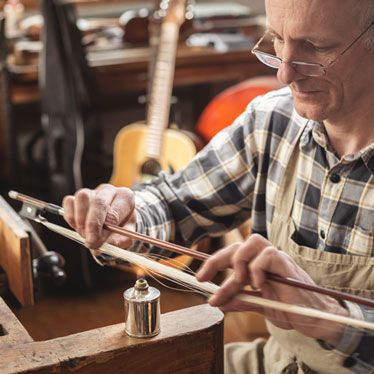How to Replace Your Instrument’s Bow Hair

The good news is unless you’re in a group like Apocalyptica, you won’t need to replace your instrument’s bow hairs nearly as often as you need to change its strings. Even so, bow hairs break, wear out, and become sticky and dirty over time – all of which compromise bowing technique, as well as the quality of your sound.
When it’s time to rehair your bow, we recommend having it done by a professional, although some proficient and handy musicians master the art form on their own. To that end, we’ve provided step-by-step instructions.
A bow needs to be rehaired when…
The bow of the average music student should only need rehairing about once every two years or so. More diligent students and professional musicians may rehair their bows every two to six months. The better you care for your bow, the less frequently you’ll need to replace the hair.
The most common signs it’s time to rehair your bow include:
- More hairs are broken on one side than the other. This causes uneven tension on the stick. Over time, the bow stick warps, requiring yet another repair. Incidentally, improperly replacing your instrument’s bow hairs can have the same effect.
- Hair loss in the middle. Similarly, putting too much tension on the strings can chew up bow hairs in the middle, compromising sound and altering your bowing.
- It’s sticky, discolored, and/or smelly. All bows eventually become sticky, discolored, and even smelly. This is due to the combination of rosin, dust, general grime, and finger residue from accidental touching. Always wipe your bow off – just like your instrument – each time you play. Read, The String Musician’s Ultimate Guide to Rosin, to ensure you’re using high-quality rosin and rosining techniques.
Have it done by a professional
While many prolific string musicians learn to rehair their bow independently, most musicians take their bow to a professional. The cost of rehairing a violin bow is typically around $50 or less, a bit more for cello and bass bows. That’s roughly the same price as a single private lesson, a worthwhile investment to ensure it is done correctly.
If you haven’t found your preferred luthier yet, ask your music teacher or a local music shop for a referral. Proof that rehairing bows isn’t as easy as it seems. As an award-winning luthier, David Burgess, posted on violinist.com, “If you want a really good rehair, it's not easy at all. People train for years, with regular coaching, to learn how to do it well, and to do it with minimal risk of damage to the bow.”
Are you a committed, DIY type and want to learn to rehair bows on your own? We recommend buying a new, high-quality Revelle bow for yourself – and practicing the technique on an old bow, so you don’t risk doing permanent damage to the one you use for practice and performance. We also suggest using Coruss bow hair, a vegan synthetic option, designed as an alternative to horsehair to eliminate the common problems of breakage, sensitivity to humidity and temperature, consistency, and premature wear.
Tips for Rehairing a Bow
Most string musicians initially want to rehair their own bow to save money. However, replacing bow hair is not only a special skill, it also requires specialty tools – an additional investment. You may find that’s another reason to hand the task off to professionals. Coruss created this video demonstration of how to prepare their bow hair, which shows some of the tools and techniques required for the job.
The following tips are generously offered by the Callier-Scollard Violin Shop, located in Pasadena, California. You’ll notice the steps are quite numerous and detailed, and this violin shop only charges $22 to rehair a bow – when you do the math, that’s less than $0.50 cents per step!
- Inspect the stick
- Cut out the hair leaving about 4 inches at each end
- Clean the metal of the frog and the button
- Clean the winding
- Glue the thumb grip if it's loose
- Remove the tip block
- Clean the stick
- If necessary adjust how snug the frog fits on the stick
- Carefully remove the ferrule ring
- Remove the slide
- Lubricate the slide slot with a pencil, so it's easier to remove the next time.
- Remove the block.
- Cut the block for the frog's mortise, matching the length of the block mortise minus the thickness of the hair. Most of the time if I rehaired it last time I can reuse the block.
- Select the correct amount of horse hair for the bow
- Tie the hair very tightly with very strong cotton blend thread using the correct length for the block mortise hole
- Cut the hair and tap the end into some crushed rosin
- Burn the end of the hair
- Put the hair into the block mortise hole so that it's flat and snug in the mortise
- Put crushed rosin on the end of the block.
- Push the block into the block mortise hole.
- The hair will be flipped over the block. It should fit very snugly. Give a little pull on the hair to make sure the block does not move.
- Replace the slide into the slots on the frog.
- Replace the ferrule ring.
- Make a new wedge. Some people reuse wedges, but most of the time they will not fit correctly, so I always make a new wedge
- Spread the hair across the ring and test the wedge. It should fit tightly and keep the hair evenly spaced
- Next measure how far the frog needs to be back from the grip.
- Make the tip block
- Comb the hair so that the comb runs smoothly through the hair
- Wet the hair but don't let water get next to the wedge
- Comb the hair and keep an even pressure
- Hold the hair with one hand and tie the hair just after the tip block mortise.
- Once the correct hair length is set, finish tying to the knot to correct length using a very strong cotton blend thread
- Cut the hair after the cotton blend tied knot
- Tamp the end of the hair into crushed rosin and then burn the ends of the horse hair.
- The width of the tie should allow the hair to get pushed into the tip block hole but be snug.
- Comb the hair again using an even amount of pressure
- Hold the hair between your fingers, keeping the hair even.
- Flip the hair over and put the tied end into the block mortise
- Put rosin on the end of the block and push it in over the hair
- The hair should be even
- Lubricate the bow screw
- Flip the hair back over and replace the frog
- Tighten up the hair a little
- At this point, if needed, the hair can be adjusted slightly
- Keep the bow at a little bit of tension while the hair is drying. Do not allow water to wick into the wedge
- After about an hour adjust the tension again on the stick because as the hair dries, it gets a little shorter
- After the hair is dry, apply powdered rosin to violin, viola, and cello bows. I don't rosin bass bows.
Once your bow is rehaired and rosined up (it takes about 40 to 50 passes across a rosin cake to rosin new bow hairs), it may feel a little different. This is perfectly normal. With a little practice time and some minor bowing or pressure adjustments, you’ll be back to playing as usual.


